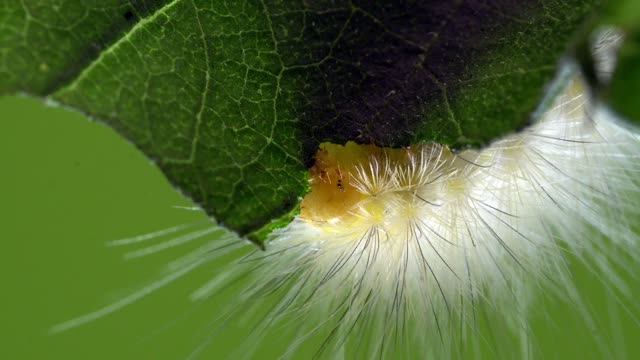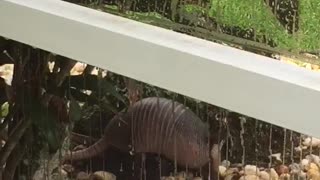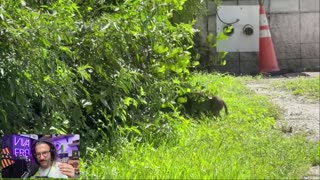Premium Only Content

Eating My Garden
Furry caterpillars are a fascinating type of insect that usually turn into moths. Most types of furry caterpillars feed on the leaves of plants and trees. Although many hairy caterpillars look scary, most are quite harmless. There are some spiky caterpillars that are poisonous and can give you a bee-like sting or cause skin irritation. So, until you identify the exact caterpillar species, you should avoid handling the furry ones without protective gloves.
How to Identify Caterpillars
Identifying fuzzy caterpillars requires noting their color, type of hairy covering, and specific markings. Some types of furry caterpillars also look deceiving. For example, some woolly caterpillars look like soft furry worms. However, their bristles are a defense mechanism and can be spiky and sore. Although their ‘sting’ won’t cause lasting harm, their poisonous stings can cause allergic reactions in some people.
In this article, you will learn how to identify the various types of common furry caterpillars. In addition, you will find out about the poisonous stinging caterpillars to be aware of.
Types of Furry Caterpillars With Pictures and Names
The descriptions of the various caterpillars in this list are of mature larvae in their last stage before pupation. After hatching from an egg, the larvae are constantly feeding on plants and growing in size. So, an immature caterpillar may look different from a mature furry one.
Banded Woolly Bear Caterpillar
Wooly Bear
The Banded Woolly Bear Caterpillar is a furry type of caterpillar with black and orange hairs
The Banded Wooly Bear caterpillar (Pyrrharctia isabella) is one of the most common types of caterpillars. They are easy to identify due to their dark orange and black markings as seen in the picture. These orange and black fuzzy worms are also called ‘Isabella Tiger Moths,’ ‘Woolybears,’ or ‘Wooly Worms.’ Their bodies are made up of 13 segments
Although they look like soft furry insects, their body covering is made from bristles that can penetrate your skin. Coming into contact with a black and brown/tan woolly caterpillar can result in skin irritation. However, banded ‘woollies’ are not poisonous.
Some people used to think that Banded Woolybears could predict the severity of winter. A wider orange band in the middle was said to mean that the winter would be mild.
Identifying features
You can spot banded woolly caterpillars due to the black hairy covering on the ends and a wide brown or tan band of hair in their middle.
Banded woollybear caterpillars roll up into a ball when they feel threatened.
They grow to just over 2” (5 cm) before the pupal stage and turning into a moth.
Salt Marsh Caterpillar
salt marsh caterpillar
The hairy Salt Marsh caterpillar can vary in color from tan to dark brown, almost black
The Salt Marsh caterpillar (Estigmene acrea) is another furry caterpillar that feeds on tomato, cotton, soybean, and cabbage plants. The larvae of the Salt Marsh moth can range in color from pale yellow to dark brown, almost black.
Although the black and brown covering looks spiky, these are soft bristles that aren’t sharp. However, similar to ‘woolly’ caterpillars, the fine hair-like spines can get under your skin and irritate it.
Identifying features
You can identify these caterpillars apart from Banded Woolly ones because of rows of black spots along their side.
These medium-sized dark brown fuzzy caterpillars grow to just over 2” (5 cm) in length.
Sycamore Tussock Caterpillar
Sycamore Tussock caterpillar
The white furry Sycamore Tussock caterpillar has an unusual pair of spikes on each end
The Tussock caterpillar (Halysidota harrisii) gets its name because it feeds on sycamore trees. This species belongs to the Erebidae family of crawling insects.
The Sycamore Tussock is an unusual looking white caterpillar due to 2 hair pencils protruding from each end. A pair of white and a pair of orange long spikes stick out from furry yellowish-white spines. The sides of the larvae have fine white trailing setae (bristly hairs).
As with many types of fuzzy caterpillars, the bristles are irritating and may cause hives. These are not a stinging species and are certainly not a deadly caterpillar variety.
-
 3:09
3:09
Cahlen
4 years agoSomething's Eating the Garden!
16 -
 0:35
0:35
Oodiggy
4 years agoArmadillo eating bugs in our garden
14 -
 1:03
1:03
danpzu
4 years agoPart 3 transforming Outdoor eating area to Covid garden
36 -
 2:04
2:04
OzFlor
4 years agoEating from garden plantation
91 -
 0:23
0:23
Funny, Natural, animals, space,pets
4 years agoBunny rabbits eating together in garden
120 -
 LIVE
LIVE
DLDAfterDark
3 hours ago $0.11 earnedThe Assassination of Charlie Kirk - Just What We KNOW
200 watching -
 1:33:56
1:33:56
MattMorseTV
4 hours ago $2.94 earned🔴Exposing his PARTNER IN CRIME.🔴
56.4K210 -
 1:26:51
1:26:51
vivafrei
8 hours agoCharlie Kirk Assassination - When Peaceful Discussion Becomes Impossible - With Jose Vege
83K182 -
 2:04:12
2:04:12
Mally_Mouse
1 day ago🌶️ 🥵Spicy BITE Saturday!! 🥵🌶️- Let's Play: Supermarket Together
39.5K2 -
 1:15:37
1:15:37
BooniesHQ
8 hours ago $6.64 earnedGame Of SKATE Donny Hixson Vs. Chris Massie: Boonies Skate Night 2
60.7K7